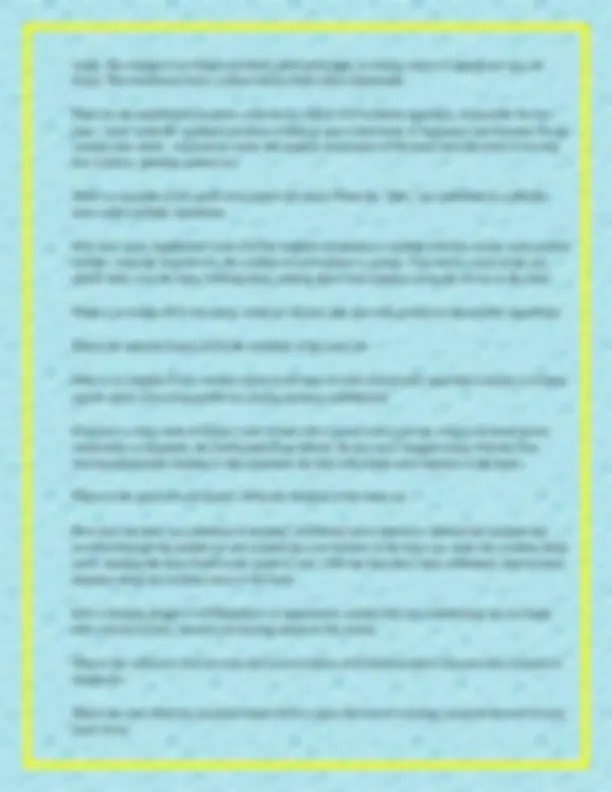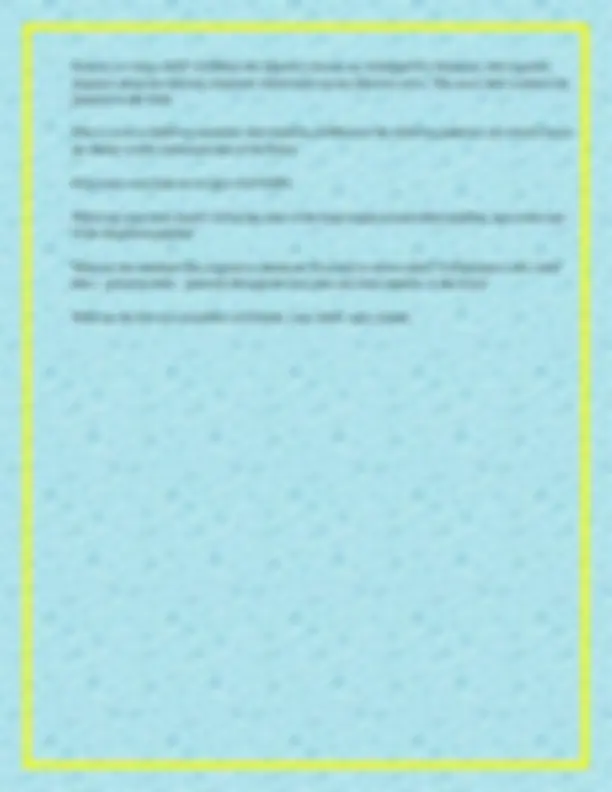




Study with the several resources on Docsity

Earn points by helping other students or get them with a premium plan


Prepare for your exams
Study with the several resources on Docsity

Earn points to download
Earn points by helping other students or get them with a premium plan
Community
Ask the community for help and clear up your study doubts
Discover the best universities in your country according to Docsity users
Free resources
Download our free guides on studying techniques, anxiety management strategies, and thesis advice from Docsity tutors
five senses,sense of equilibrium housed,
Typology: Quizzes
1 / 4

This page cannot be seen from the preview
Don't miss anything!



What are the five senses ✔✔Taste, smell, equilibrium, sight and hearing (touch is now considered a general sense, not a special one) Where is the sense of equilibrium housed? ✔✔the ear what percent of sensory receptors are found in they eye ✔✔70% How much of the surface of the eye can be seen? ✔✔One sixth (called the palpebral fissure - the bit between your eyelids) What are the edgepoints of the eyelids called ✔✔The commissures (medial and lateral) What are the glands at the eyelid edge and what do they secrete ✔✔The glands are tarsal glands, and they produce an oily secretion that lubricates the eye Where is the lacrimal gland ✔✔Outer edge of top of eyelid between eyebrow and lid. What is the name of the mucouse membrane of the eye ✔✔Conjunctiva - only covers the white of the eye and contains the vessels that make your eye bloodshot (it stops at the cornea) What are the components of the lacrimal apparatus ✔✔The lacrimal gland (produces tears) and the lacrimal ducts (drain the tears onto the conjunctiva Where do tears start from and go to ✔✔They are produced in the lacrimal gland and released onto the conjunctiva by lacrimal ducts. They are then flushed across the eyeball and empty into the lacrimal canalliculi and down into the lacrimal sac, which empties into the nasal cavity. What makes up tears ✔✔dilute salt solution, also containing lysozyme, an enzyme that destroys bacteria. Why do your eyes get watery when you have allergies or a cold? ✔✔Your sinuses will be blocked, which means that tears cannot drain into them. This causes the tears to back up and make your eyes watery, or even teary. What are the three layers of the eye wall called? ✔✔Fibrous (the white, called the sclera and the cornea), the vascular (containing the choroid, ciliary body and iris) and retina (containing the pigmented and sensory layer) What is the pupil ✔✔It's a hole in the iris
What are rods and cones ✔✔They are photoreceptors (responding to light), found in the sensory layer of the retina. Rods allow us to see in dim light in gray tones and allow peripheral vision, cones allow us to perceive colour in bright light. How does vision work ✔✔Light enters our eye via the iris, where it is touches rods and cones. Electical impulses then travel along a two-neuron chain before leaving the retina via the optic nerve. What are the three types of cones ✔✔Red cones, blue cones and green cones How many parts are there to the lens ✔✔Two - The anterior segment (filled with aqueous humour) and the posterior segment (filled with vitreous humour) How does the lens work ✔✔It changes shape, from more to less convex, so that light can be properly focussed on the retina. Where are the photoreceptor cells located ✔✔They are over all of the retina, except where the optic nerve leaves the eyeball (this site is called the optic disc - it's a blind spot) What are the three main areas of the ear ✔✔External (outer) ear, middle ear and internal (inner) ear. What areas of the ear are only for hearing ✔✔outer and middle (the inner ear is both for hearing and equilibrium) What structures make up the outer ear ✔✔Auricle (the shell shaped part) the external acoustic meatus (the hole). The EAM is liknes with ceruminous glands which secrete earwax. How do we hear? ✔✔Sound waves enter the outer ear and hit the tympanic membrane (ear drum), making it vibrate. When it vibrates, the hammer moves with it and transfers the vibration to the anvil and then to the stirrup, which presses on the oval window of the inner ear. Movement at the oval window moves the fluids in the inner ear, exciting the hearing receptors. What are the parts of the middle ear? ✔✔tiny weeny bones, called the hammer (malleus), anvil (incus) and stirrup (stapes). they each transmit movement to the next. What is the pharyngotympanic tube? ✔✔It's the auditory tube that runs obliquely down to link the middle ear cavity to the throat, underneath the bones of the middle ear (the mucous membrane between the two is continuous). What structures make up the inner ear ✔✔A heap of bony chambers, deep inside the temporal bone behind the eye socket. The chambers are the cochlea, vestibule and semicircular canals (look like a
How do we sense smell? ✔✔When the olfactory sensors are stimulated by chemicals, they transmit impulses along the olfactory filaments which make up the olfactory nerve. This nerve then conducts the impulses to the brain Why is scent so linked to memories and emotions ✔✔Because the olfactory pathways are closely tied to the limbic system (emotional part of the brain). How many taste buds do we have ✔✔10, Where are taste buds found? ✔✔on the sides of the large round circumvallate papillae, and on the tops of the fungiform papillae. What are the tastebuds that respond to chemicals dissolved in saliva called? ✔✔Gustatory cells. (their hairs - gustatory hairs - protrude through the taste pore and send impulses to the brain) What are the five tast sensations? ✔✔Sweet, sour, bitter, salty, umami